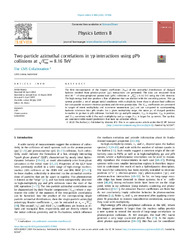Two-particle azimuthal correlations in γp interactions using pPb collisions at √sNN = 8.16 TeV
| dc.contributor.author | Tumasyan, A. | |
| dc.contributor.author | Işıldak, Bora | |
| dc.date.accessioned | 2024-02-21T06:25:34Z | |
| dc.date.available | 2024-02-21T06:25:34Z | |
| dc.date.issued | 2023-09-10 | |
| dc.identifier.issn | 0370-2693 | en_US |
| dc.identifier.uri | http://hdl.handle.net/10679/9184 | |
| dc.identifier.uri | https://www.sciencedirect.com/science/article/pii/S0370269323002393 | |
| dc.description.abstract | The first measurements of the Fourier coefficients (VnΔ) of the azimuthal distributions of charged hadrons emitted from photon-proton (γp) interactions are presented. The data are extracted from 68.8 nb−1 of ultra-peripheral proton-lead (pPb) collisions at sNN=8.16TeV using the CMS detector. The high energy lead ions produce a flux of photons that can interact with the oncoming proton. This γp system provides a set of unique initial conditions with multiplicity lower than in photon-lead collisions but comparable to recent electron-positron and electron-proton data. The VnΔ coefficients are presented in ranges of event multiplicity and transverse momentum (pT) and are compared to corresponding hadronic minimum bias pPb results. For a given multiplicity range, the mean pT of charged particles is smaller in γp than in pPb collisions. For both the γp and pPb samples, V1Δ is negative, V2Δ is positive, and V3Δ consistent with 0. For each multiplicity and pT range, V2Δ is larger for γp events. The γp data are consistent with model predictions that have no collective effects. © 2023 The Author(s) | en_US |
| dc.description.sponsorship | BMBWF and FWF (Austria); FNRS and FWO (Belgium); CNPq, CAPES, FAPERJ, FAPERGS, and FAPESP (Brazil); MES and BNSF (Bulgaria); CERN; CAS, MOST, and NSFC (China); MINCIENCIAS (Colombia); MSES and CSF (Croatia); RIF (Cyprus); SENESCYT (Ecuador); MoER, ERC PUT and ERDF (Estonia); Academy of Finland, MEC, and HIP (Finland); CEA and CNRS/IN2P3 (France); BMBF, DFG, and HGF (Germany); GSRI (Greece); NKFIH (Hungary); DAE and DST (India); IPM (Iran); SFI (Ireland); INFN (Italy); MSIP and NRF (Republic of Korea); MES (Latvia); LAS (Lithuania); MOE and UM (Malaysia); BUAP, CINVESTAV, CONACYT, LNS, SEP, and UASLP-FAI (Mexico); MOS (Montenegro); MBIE (New Zealand); PAEC (Pakistan); MES and NSC (Poland); FCT (Portugal); MESTD (Serbia); MCIN/AEI and PCTI (Spain); MoSTR(Sri Lanka); Swiss Funding Agencies (Switzerland); MST (Taipei); MHESI and NSTDA (Thailand); TUBITAK and TENMAK (Turkey); NASU (Ukraine); STFC (United Kingdom); DOE and NSF (USA).r Individuals have received support from the Marie-Curie program and the European Research Council and Horizon 2020 Grant, contract Nos. 675440, 724704, 752730, 758316, 765710, 824093, 884104, and COST Action CA16108 (European Union); the Leventis Foundation; the Alfred P. Sloan Foundation; the Alexander von Humboldt Foundation; the Belgian Federal Science Policy Office; the Fonds pour la Formation a la Recherche dans l'Industrie et dans l'Agriculture (FRIA-Belgium); the Agentschap voor Innovatie door Wetenschap en Technologie (IWT-Belgium); the F.R.S.-FNRS and FWO (Belgium) under the "Excellence of Science-EOS" - be.h project n. 30820817; the Beijing Municipal Science & Technology Commission, No. Z191100007219010; The Ministry of Education, Youth and Sports(MEYS) of the Czech Republic; the Hellenic Foundation for Research and Innovation (HFRI), Project Number 2288 (Greece); the Deutsche Forschungsgemeinschaft (DFG), under Germany's Excellence Strategy -EXC 2121 "Quantum Universe" - 390833306, and under project number 400140256 - GRK2497; the Hungarian Academy of Sciences, the New National Excellence Program -UNKP, the NKFIH research grants K 124845, K 124850, K 128713, K 128786, K 129058, K 131991, K 133046, K 138136, K 143460, K 143477, 2020-2.2.1-ED-2021-00181, and TKP2021-NKTA-64 (Hungary); the Council of Science and Industrial Research, India; the Latvian Council of Science; the Ministry of Education and Science, project no. 2022/WK/14, and the National Science Center, contracts Opus 2021/41/B/ST2/01369 and 2021/43/B/ST2/01552 (Poland); the Fundacao para a Ciencia e a Tecnologia, grant CEECIND/01334/2018 (Portugal); the National Priorities Research Program by Qatar National Research Fund; MCIN/AEI/10. 13039/501100011033, ERDF "a way of making Europe", and the Programa Estatal de Fomento de la Investigacion Cientifica y Tecnica de Excelencia Maria de Maeztu, grant MDM-2017-0765 and Programa Severo Ochoa del Principado de Asturias (Spain); the Chulalongkorn Academic into Its 2nd Century Project Advancement Project, and the National Science, Research and Innovation Fund via the Program Management Unit for Human Resources & Institutional Development, Research and Innovation, grant B05F650021 (Thailand); the Kavli Foundation; the Nvidia Corporation; the SuperMicro Corporation; the Welch Foundation, contract C-1845; and the Weston Havens Foundation (USA). | |
| dc.language.iso | eng | en_US |
| dc.publisher | Elsevier | en_US |
| dc.relation.ispartof | Physics Letters B | |
| dc.rights | openAccess | |
| dc.rights | Attribution 4.0 International | |
| dc.rights.uri | https://creativecommons.org/licenses/by/4.0/ | |
| dc.title | Two-particle azimuthal correlations in γp interactions using pPb collisions at √sNN = 8.16 TeV | en_US |
| dc.type | Article | en_US |
| dc.description.version | Publisher version | en_US |
| dc.peerreviewed | yes | en_US |
| dc.publicationstatus | Published | en_US |
| dc.contributor.department | Özyeğin University | |
| dc.contributor.authorID | (ORCID 0000-0002-0283-5234 & YÖK ID 124605) Işıldak, Bora | |
| dc.contributor.ozuauthor | Işıldak, Bora | |
| dc.creator | The CMS Collaboration | |
| dc.identifier.volume | 844 | en_US |
| dc.identifier.wos | WOS:001060187600001 | |
| dc.identifier.doi | 10.1016/j.physletb.2023.137905 | en_US |
| dc.subject.keywords | CMS | en_US |
| dc.subject.keywords | Collectivity | en_US |
| dc.subject.keywords | Photon-proton | en_US |
| dc.identifier.scopus | SCOPUS:2-s2.0-85168004410 | |
| dc.relation.publicationcategory | Article - International Refereed Journal - Institutional Academic Staff |
Files in this item
This item appears in the following Collection(s)
Share this page




